Chapter 4 – Sections & Objectives
- 4.1 Standard ACL Operation and Configuration
- Configure standard IPv4 ACLs.
- 4.2 Extended IPv4 ACLs
- Configure extended IPv4 ACLs.
- 4.3 IPv6 ACLs
- Configure IPv6 ACLs.
- 4.4 Troubleshoot ACLs
- Troubleshoot ACLs.
4.1 Standard ACL Operation and Configuration Review
ACLs and the Wildcard Mask
- An ACL is a sequential list of permit or deny statements, known as access control entries (ACEs).
- As network traffic passes through an interface configured with an ACL, the router compares the information within the packet against each ACE.
- ACLs and the Wildcard Mask cont…
An IPv4 ACE includes the use of a wildcard mask to filter IPv4 addresses.
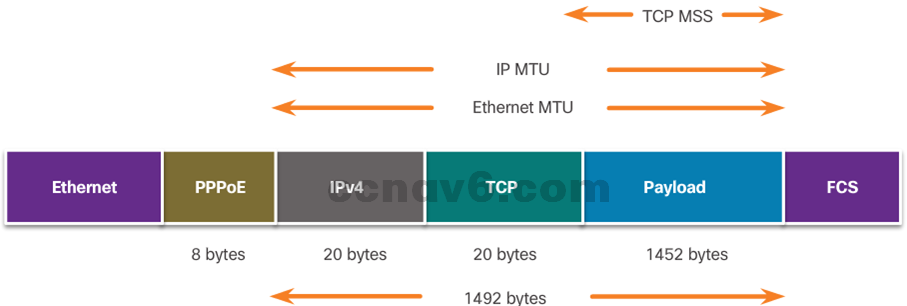
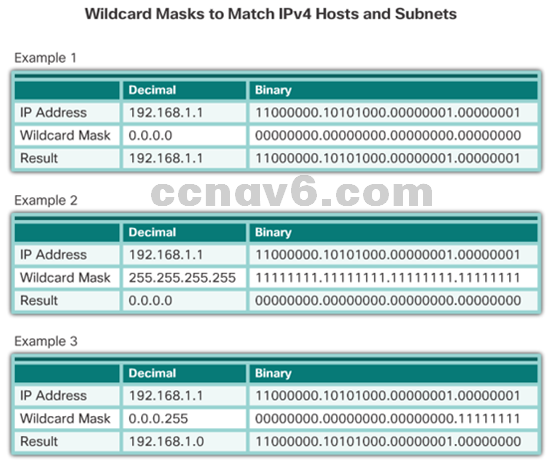
Applying ACLs to an Interface
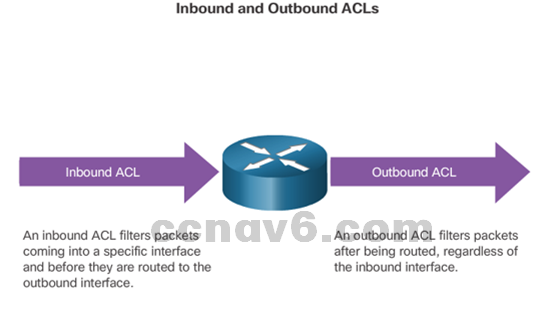
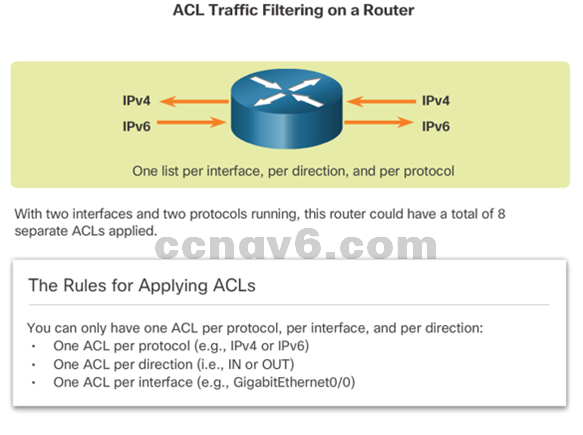
A TCP Conversation
TCP segments are marked with flags that denote their purpose:
-
- a SYN starts (synchronizes) the session
- an ACK is an acknowledgment that an expected segment was received
- a FIN finishes the session.

The TCP data segment also identifies the port which matches the requested service.

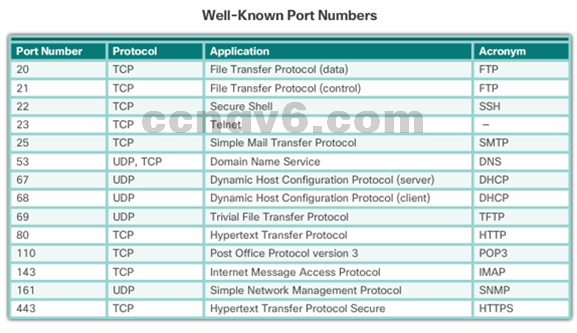
ACL Packet Filtering
Packet filtering controls access to a network by analyzing the incoming and outgoing packets and forwarding them or discarding them based on given criteria.
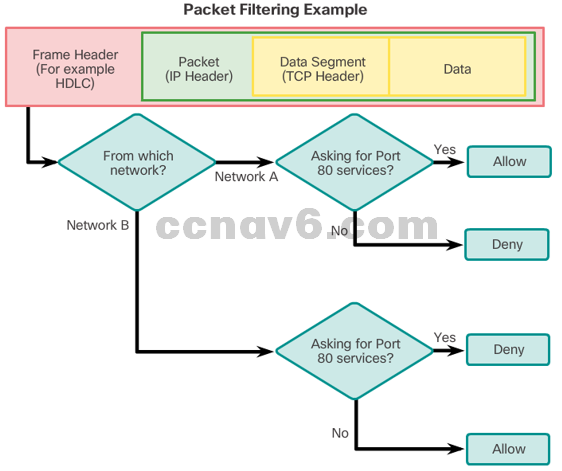
Standard and Extended IPv4 ACLs
Two types of Cisco IPv4 ACLS:
- Standard
- Standard ACLs can be used to permit or deny traffic only from source IPv4 addresses. The destination of the packet and the ports involved are not evaluated
- Extended
- Extended ACLs filter IPv4 packets based on several attributes:
- Protocol type
- Source IPv4 address
- Destination IPv4 address
- Source TCP or UDP ports
- Destination TCP or UDP ports
- Optional protocol type information for finer control
- Extended ACLs filter IPv4 packets based on several attributes:

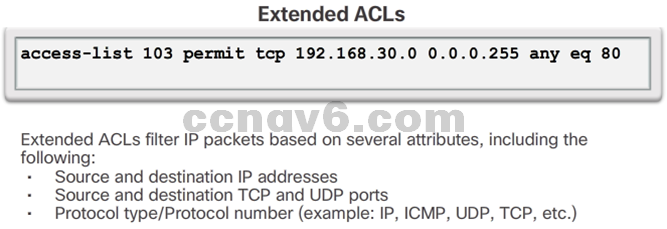
Numbered and Named ACLs
Standard and extended ACLs can be created using either a number or a name to identify the ACL.

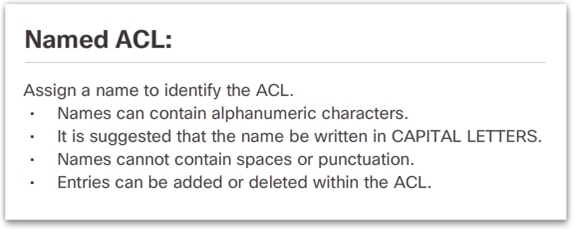
Where to Place ACLs
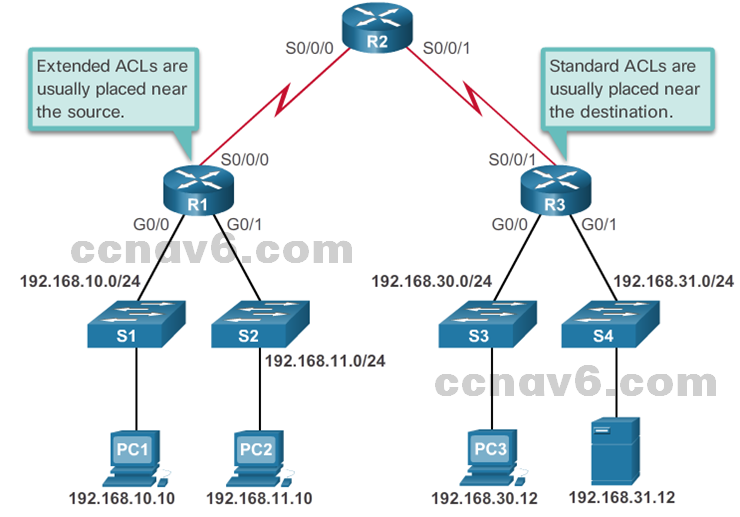
Every ACL should be placed where it has the greatest impact on efficiency. The basic rules are:
- Extended ACLs – Locate extended ACLs as close as possible to the source of the traffic to be filtered.
- Standard ACLs – Because standard ACLs do not specify destination addresses, place them as close to the destination as possible.
- Placement of the ACL, and therefore the type of ACL used, may also depend on: the extent of the network administrator’s control, bandwidth of the networks involved, and ease of configuration.
Standard ACL Placement Example
The administrator wants to prevent traffic originating in the 192.168.10.0/24 network from reaching the 192.168.30.0/24 network.
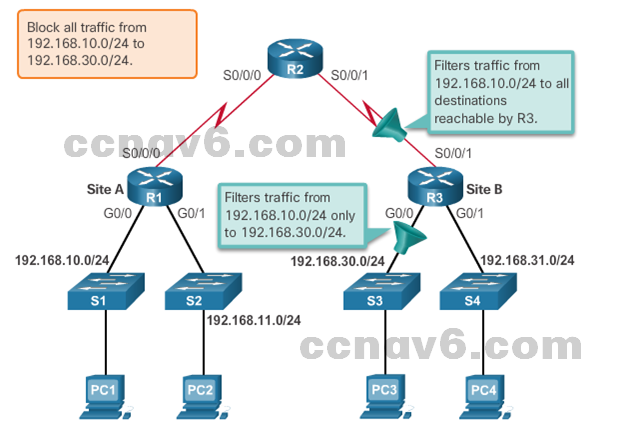
Extended ACL Placement Example
The administrator wants to deny Telnet and FTP traffic from the 192.168.11.0/24 network to Company B’s 192.168.30.0/24 network. All other traffic from the .11 network must be permitted to leave Company A without restriction.
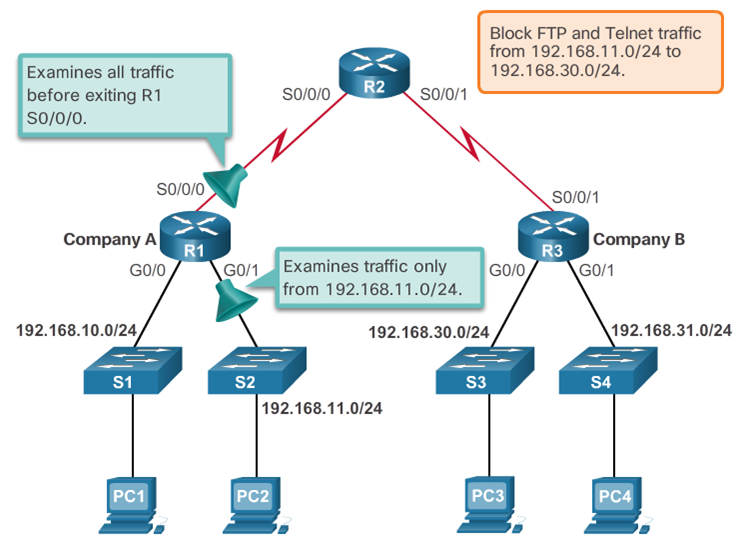
Configure a Standard IPv4 ACL
Router(config)# access-list access-list-number { deny | permit | remark } source [ source-wildcard ] [ log ]
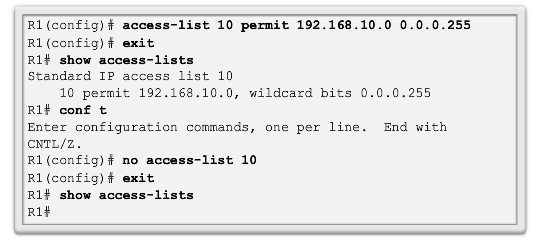

Apply a Standard IPv4 ACL
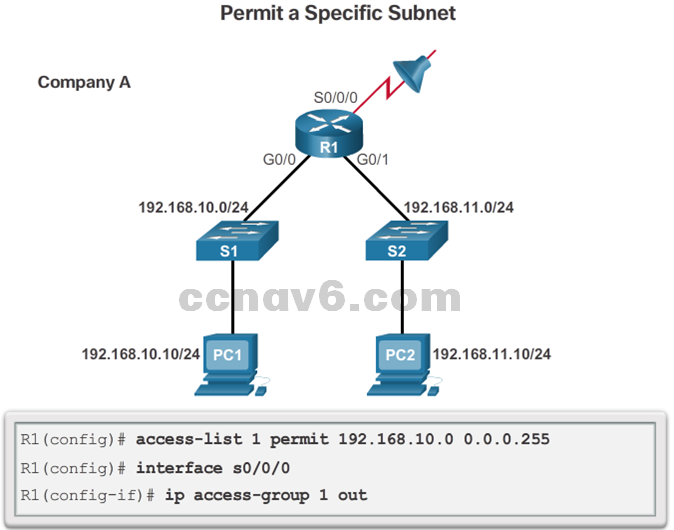
Named Standard IPv4 ACLs
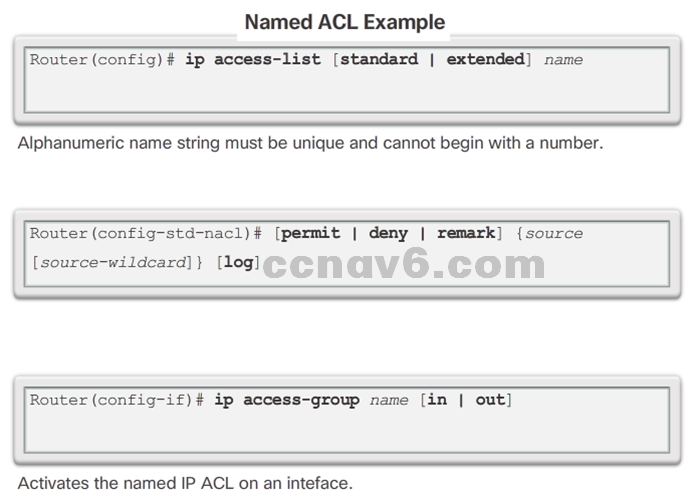
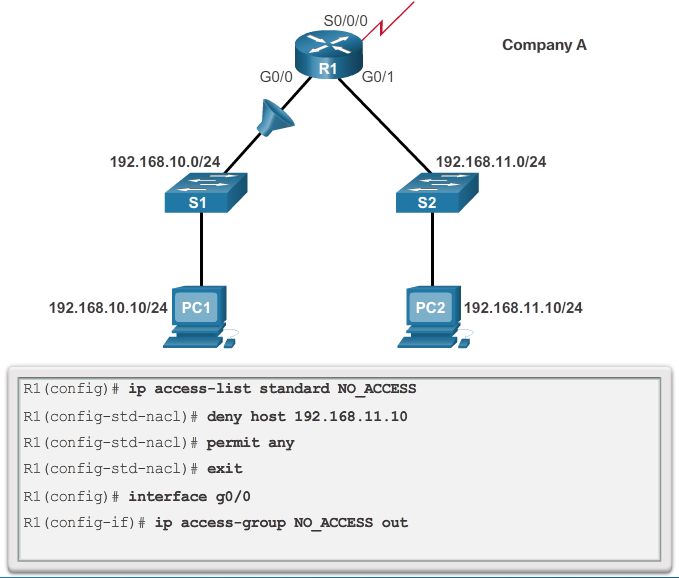
Verify ACLs
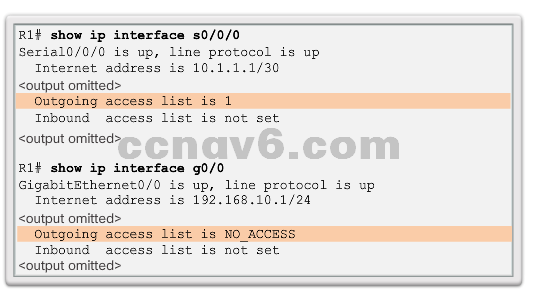
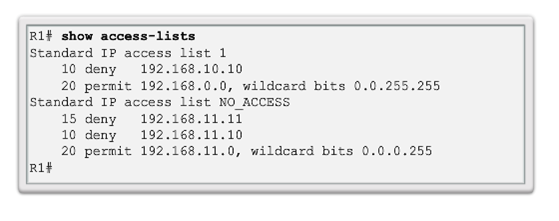
4.2 Extended IPv4 ACLs
Extended ACLs
Extended ACLs are used more often than standard ACLs because they provide a greater degree of control.
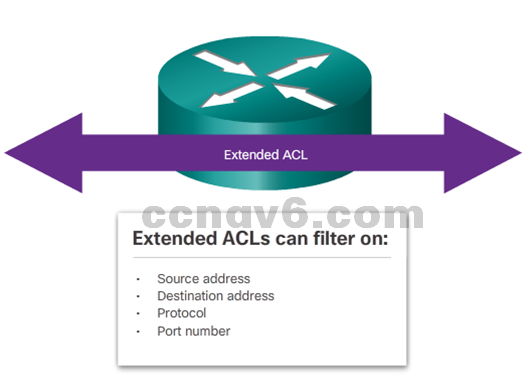
Filtering Ports and Services
- The ability to filter on protocol and port number allows network administrators to build very specific extended ACLs.
- An application can be specified by configuring either the port number or the name of a well-known port.
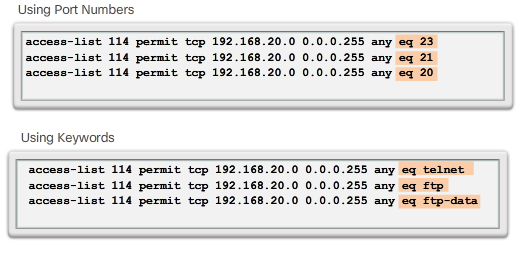
Configuring Extended ACLs
The procedural steps for configuring extended ACLs are the same as for standard ACLs. The extended ACL is first configured, and then it is activated on an interface. However, the command syntax and parameters are more complex to support the additional features provided by extended ACLs.

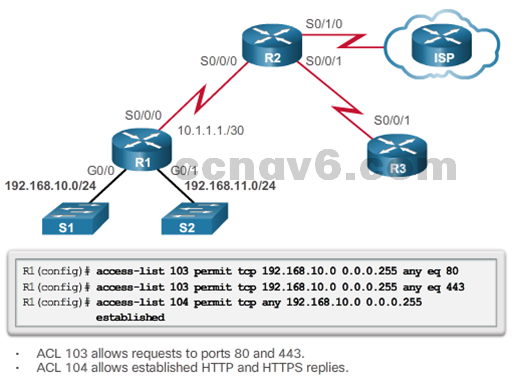
Applying Extended ACLs to Interfaces
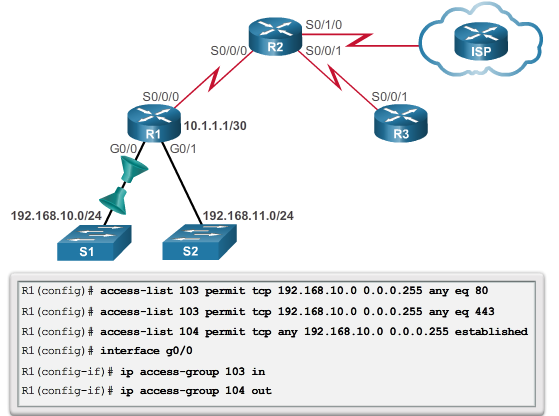
Filtering Traffic with Extended ACLs
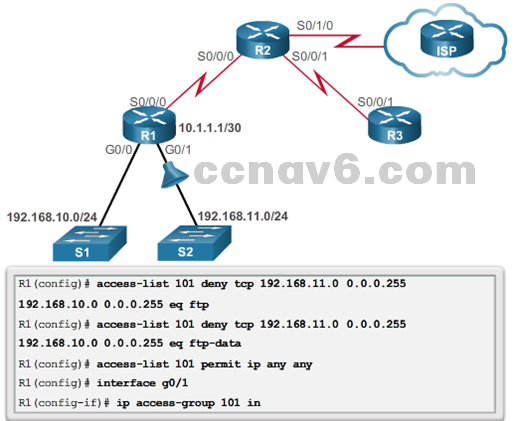
Creating Named Extended ACLs
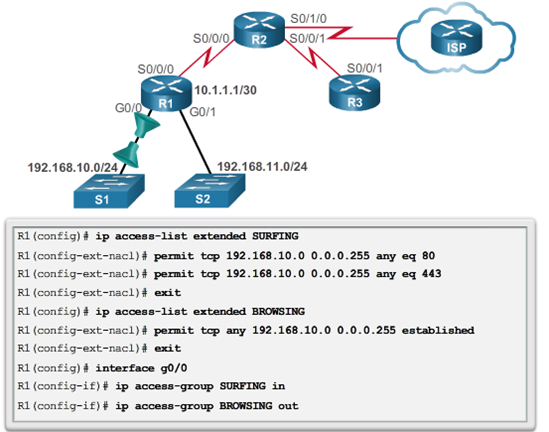
Verifying Extended ACLs
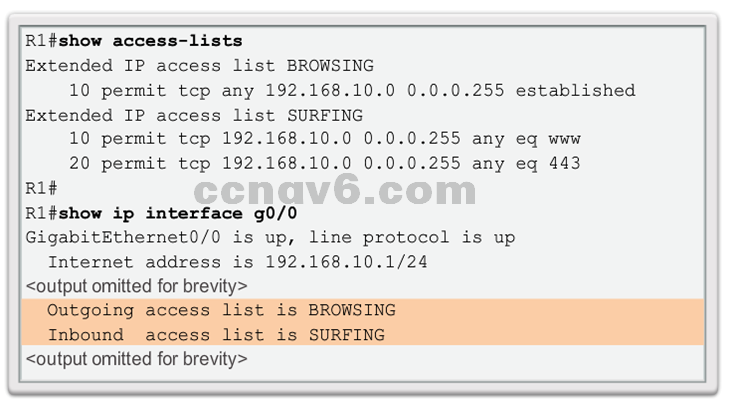
Editing Extended ACLs
Editing an extended ACL can be accomplished using the same process as editing a standard. An extended ACL can be modified using:
- Method 1 – Text editor
– The ACL is copied and pasted into the text editor where the changes are made. The current access list is removed using the no access-list command. The modified ACL is then pasted back into the configuration. - Method 2 – Sequence numbers
– Sequence numbers can be used to delete or insert an ACL statement.
Editing an extended ACL via Sequence Numbers:
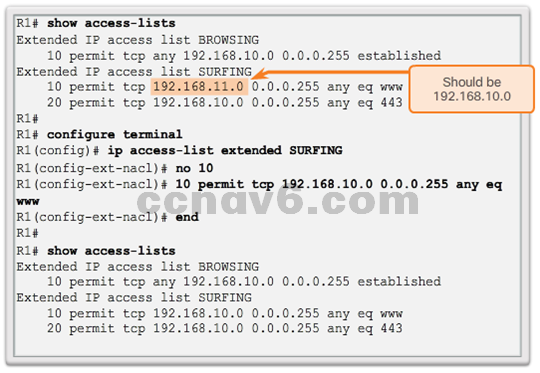
4.3 IPv6 ACLs
Types of IPv6 ACLs
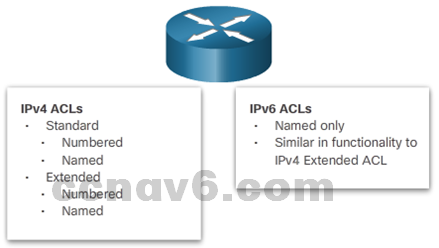
Comparing IPv4 and IPv6 ACLs
Although IPv4 and IPv6 ACLs are very similar, there are three significant differences between them.
- Applying an IPv6 ACL
– IPv6 uses the ipv6 traffic-filter command to perform the same function for IPv6 interfaces. - No Wildcard Masks
– The prefix-length is used to indicate how much of an IPv6 source or destination address should be matched. - Additional Default Statements
– permit icmp any any nd-na
– permit icmp any any nd-ns
Configuring IPv6 Topology
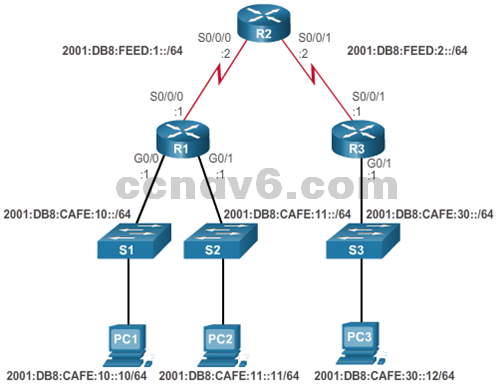
Configuring IPv6 ACLs
There are three basic steps to configure an IPv6 ACL:
- From global configuration mode, use the ipv6 access-list name command to create an IPv6 ACL.
- From the named ACL configuration mode, use permit or deny statements to specify one or more conditions to determine if a packet is forwarded or dropped.
- Return to privileged EXEC mode

This IPv6 ACL does the following:
- The first statement names the IPv6 access list NO-R3-LAN-ACCESS.
- The second statement denies all IPv6 packets from the 2001:DB8:CAFE:30::/64 destined for any IPv6 network.
- The third statement allows all other IPv6 packets.

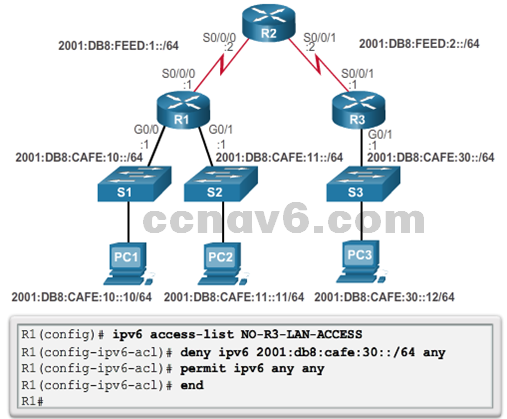
Applying an IPv6 ACL to an Interface
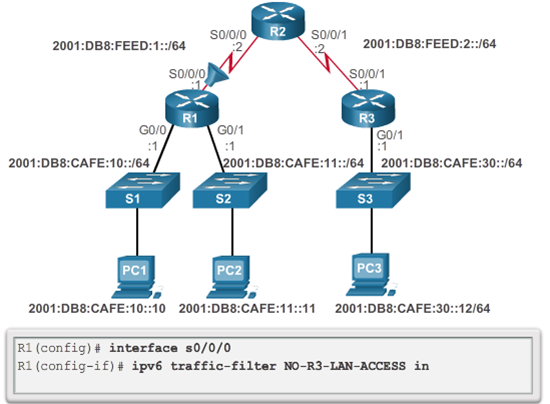
IPv6 ACL Examples
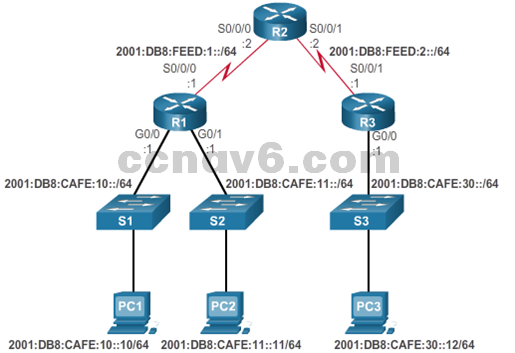
- Router R1 is configured with an IPv6 access list to deny FTP traffic to 2001:DB8:CAFE:11::/64. Ports for both FTP data (port 20) and FTP control (port 21) need to be blocked.
- Because the filter is applied inbound on the G0/0 interface on R1, only traffic from the 2001:DB8:CAFE:10::/64 network will be denied.
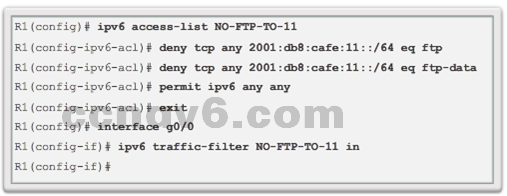
1. The first two permit statements allow access from any device to the web server at 2001:DB8:CAFE:10::10.
2. All other devices are denied access to network 2001:DB8:CAFE:10::/64.
3. PC3 at 2001:DB8:CAFE:30::12 is permitted Telnet access to PC2 which has the IPv6 address 2001:DB8:CAFE:11::11.
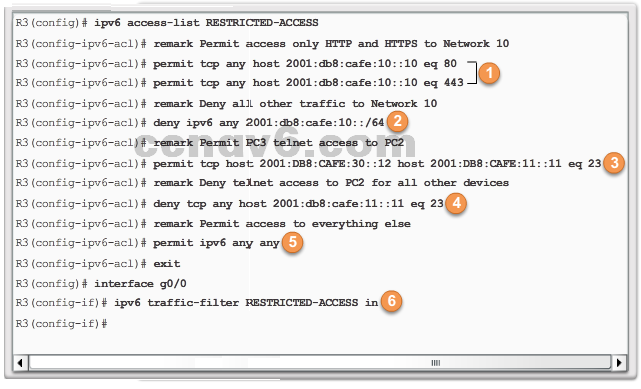
4. All other devices are denied Telnet access to PC2.
5. All other IPv6 traffic is permitted to all other destinations.
6. The IPv6 access list is applied to interface G0/0 in the inbound direction, so only the 2001:DB8:CAFE:30::/64 network is affected.
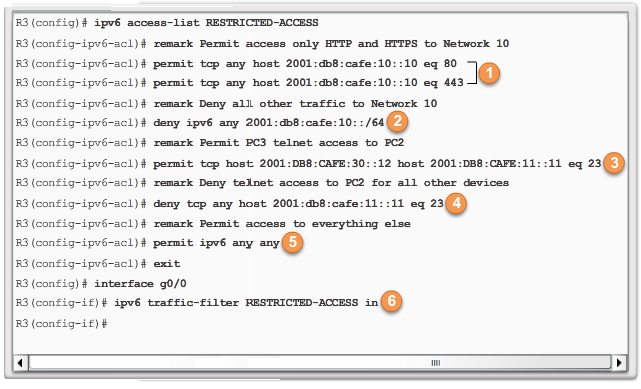
Verifying IPv6 ACLs
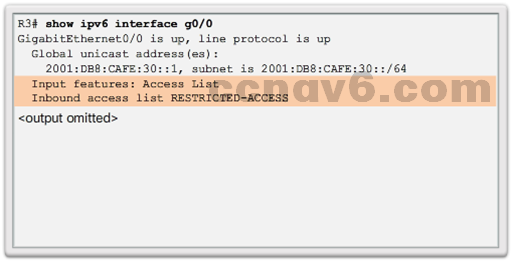

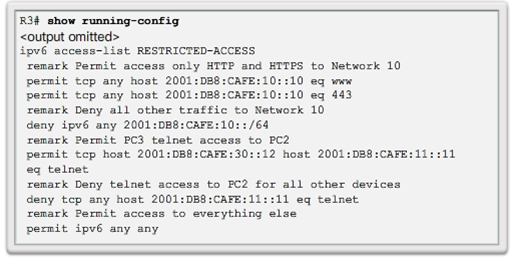
4.4 Troubleshoot ACLs
Inbound and Outbound ACL Logic
- Inbound ACL Process

- Outbound ACL Process

ACL Logic Operations
- As a frame enters an interface, the router checks to see whether the destination Layer 2 address matches its interface Layer 2 address, or whether the frame is a broadcast frame.
- If the frame address is accepted, the frame information is stripped off and the router checks for an ACL on the inbound interface.
- If an ACL exists, the packet is tested against the statements in the list.
- If the packet matches a statement, the packet is either permitted or denied.
- If the packet is accepted, it is then checked against routing table entries to determine the destination interface.
- If a routing table entry exists for the destination, the packet is then switched to the outgoing interface, otherwise the packet is dropped.
- Next, the router checks whether the outgoing interface has an ACL. If an ACL exists, the packet is tested against the statements in the list. If the packet matches a statement, it is either permitted or denied.
- If there is no ACL or the packet is permitted, the packet is encapsulated in the new Layer 2 protocol and forwarded out the interface to the next device.
Troubleshooting IPv4 ACLs- Example 1
Host 192.168.10.10 has no Telnet connectivity with 192.168.30.12.
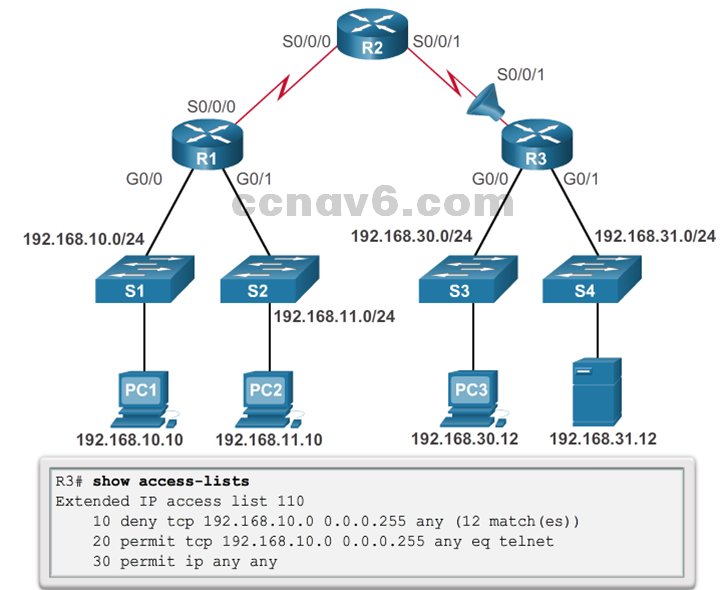
Troubleshooting IPv4 ACLs- Example 2
The 192.168.10.0/24 network cannot use TFTP to connect to the 192.168.30.0/24 network.

Troubleshooting IPv4 ACLs- Example 3
The 192.168.11.0/24 network can use Telnet to connect to 192.168.30.0/24, but this connection should not be allowed.
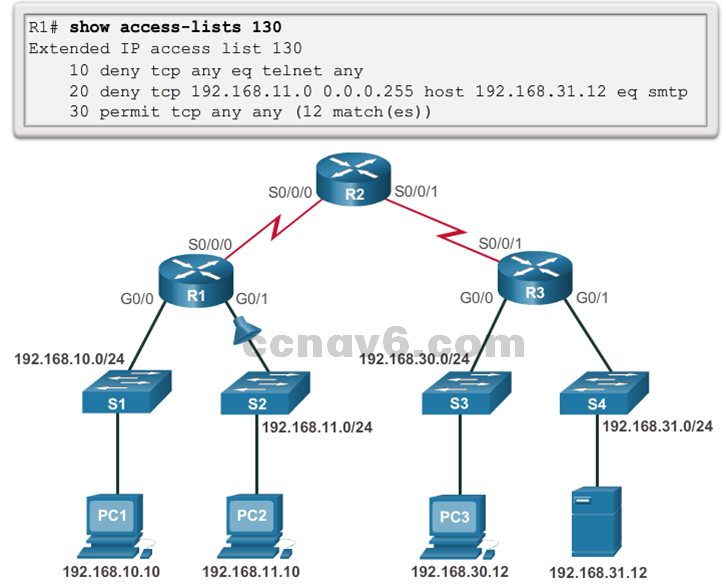
Troubleshooting IPv4 ACLs- Example 4
Host 192.168.30.12 is able to Telnet to connect to 192.168.31.12, but this connection should not be allowed.

Troubleshooting IPv4 ACLs- Example 5
Host 192.168.30.12 can use Telnet to connect to 192.168.31.12, but this connection should not be allowed.

Troubleshooting IPv6 ACLs- Example 1
R1 is configured with an IPv6 ACL to deny FTP access from the :10 network to the :11 network, but PC1 is still able to connect to the FTP server running on PC2.
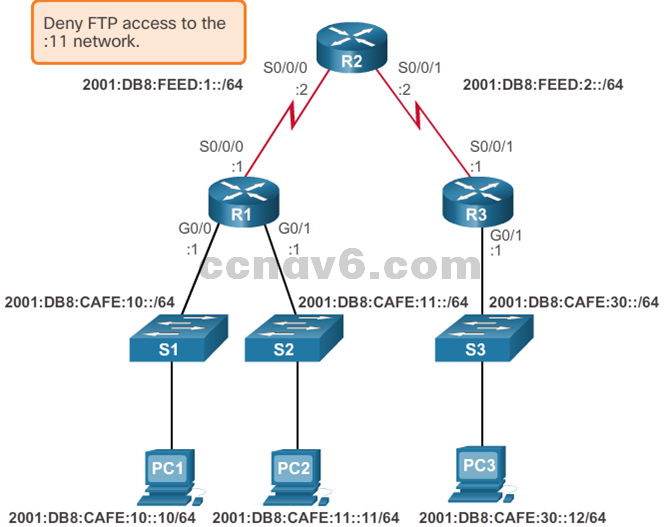

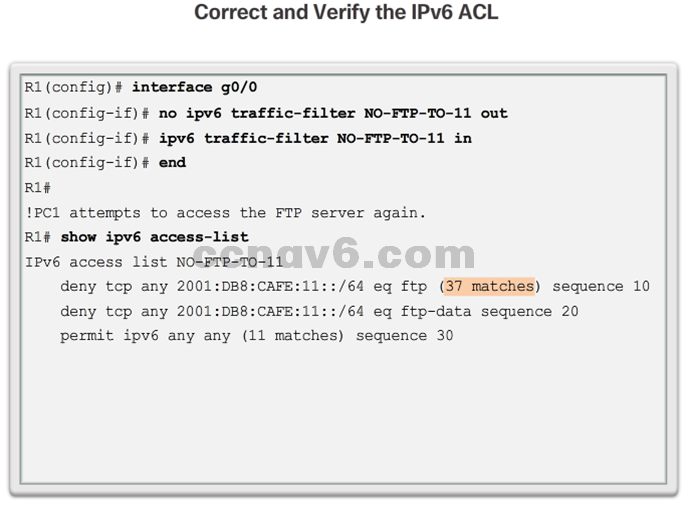
Troubleshooting IPv6 ACLs- Example 2
R3 is configured with IPv6 ACL RESTRICTED-ACCESS that should enforce the following policy for the R3 LAN:
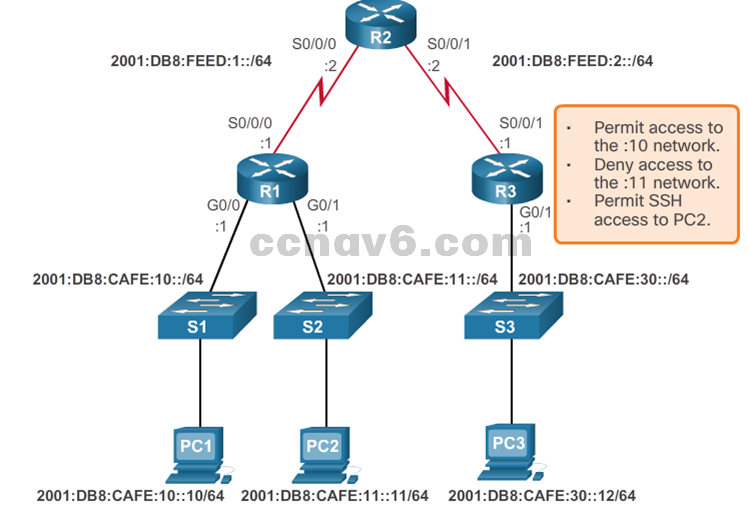
However, after configuring the ACL, PC3 cannot reach the 10 network or the 11 network, and it cannot SSH into the host at 2001:DB8:CAFE:11::11.


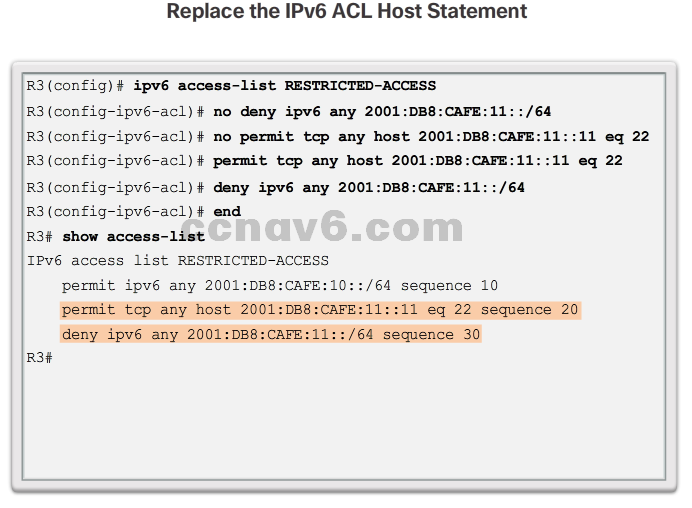
Troubleshooting IPv6 ACLs- Example 3
-
- R1 is configured with IPv6 ACL DENY-ACCESS that should enforce the following policy for the R3 LAN:
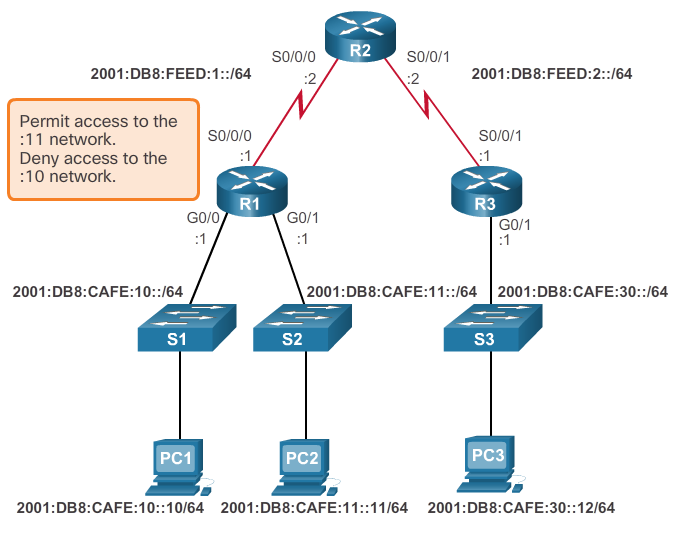
-
- However, after applying the ACL to the interface the :10 network is still reachable from the :30 network.
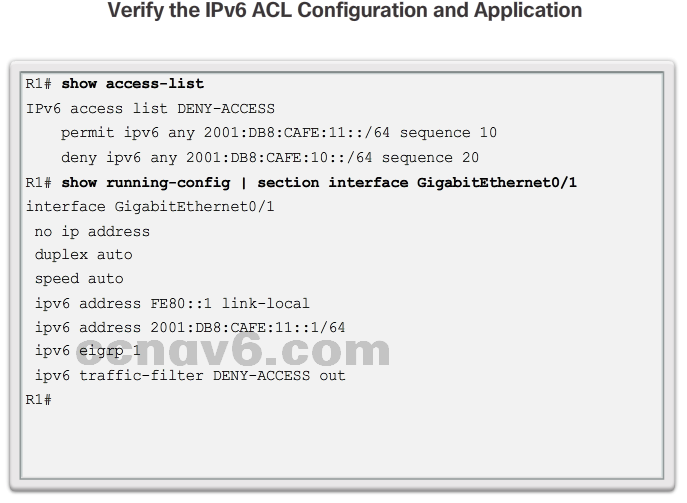
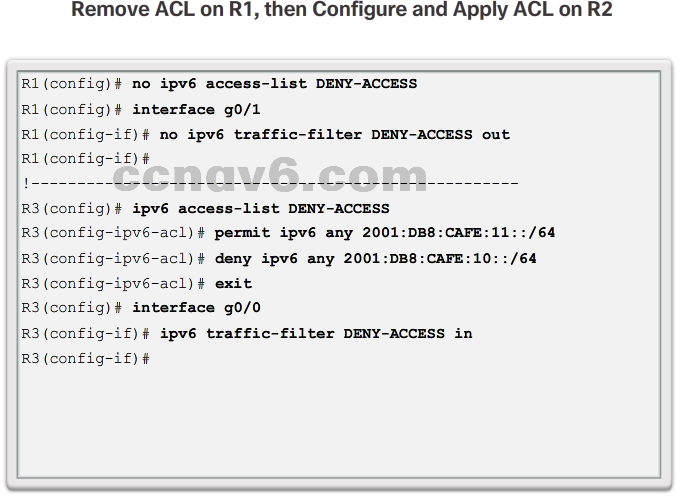
4.5 Chapter Summary
Summary
- By default a router does not filter traffic. Traffic that enters the router is routed solely based on information within the routing table.
- An ACL is a sequential list of permit or deny statements. The last statement of an ACL is always an implicit deny any statement which blocks all traffic. To prevent the implied deny any statement at the end of the ACL from blocking all traffic, the permit ip any any statement can be added.
- When network traffic passes through an interface configured with an ACL, the router compares the information within the packet against each entry, in sequential order, to determine if the packet matches one of the statements. If a match is found, the packet is processed accordingly.
- ACLs can be applied to inbound traffic or to outbound traffic.
- Standard ACLs can be used to permit or deny traffic only from a source IPv4 addresses. The basic rule for placing a standard ACL is to place it close to the destination.
- Extended ACLs filter packets based on several attributes: protocol type, source or destination IPv4 address, and source or destination ports. The basic rule for placing an extended ACL is to place it as close to the source as possible.
- The access-list global configuration command defines a standard ACL with a number in the range of 1 through 99 or an extended ACL with numbers in the range of 100 to 199. The ip access-list standard name is used to create a standard named ACL, whereas the command ip access-list extended name is for an extended access list.
- After an ACL is configured, it is linked to an interface using the ip access-group command in interface configuration mode. A device an only have one ACL per protocol, per direction, per interface.
- To remove an ACL from an interface, first enter the no ip access-group command on the interface, and then enter the global no access-list command to remove the entire ACL.
- The show running-config and show access-lists commands are used to verify ACL configuration. The show ip interface command is used to verify the ACL on the interface and the direction in which it was applied.
- The access-class command configured in line configuration mode is used to link an ACL to a particular VTY line.
- Unlike IPv4, IPv6 ACLs e is no need for a standard or extended option.
- From global configuration mode, use the ipv6 access-list name command to create an IPv6 ACL. Unlike IPv4 ACLs, IPv6 ACLs do not use wildcard masks. Instead, the prefix-length is used to indicate how much of an IPv6 source or destination address should be matched.
- After an IPv6 ACL is configured, it is linked to an interface using the ipv6 traffic-filter command.
- Unlike IPv4, IPv6 ACLs do not have support for a standard or extended option.
- From global configuration mode, use the ipv6 access-list name command to create an IPv6 ACL.
- Unlike IPv4 ACLs, IPv6 ACLs do not use wildcard masks. Instead, the prefix-length is used to indicate how much of an IPv6 source or destination address should be matched.
- After an IPv6 ACL is configured, it is linked to an interface using the ipv6 traffic-filter command.
